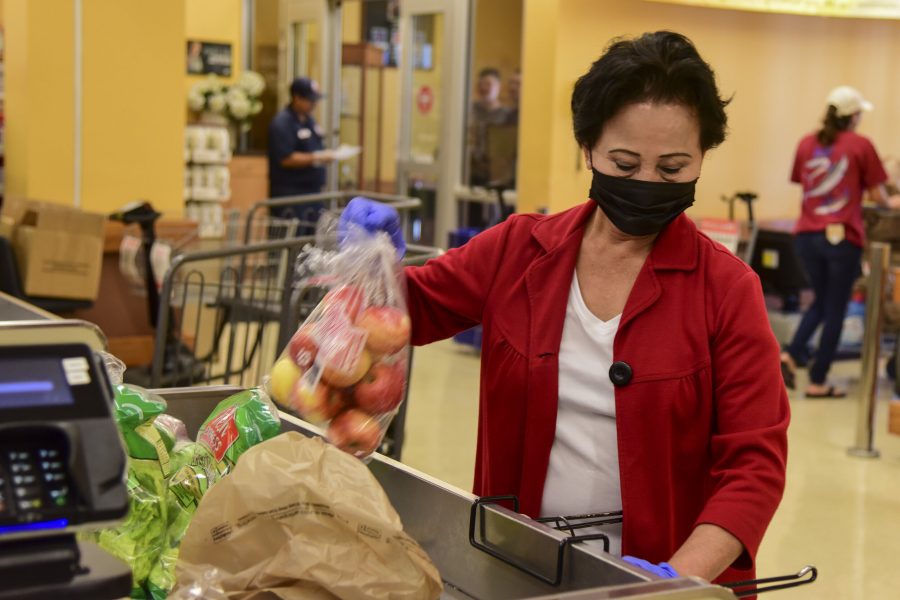Delivery service adapts to life in the age of coronavirus
April 18, 2020
Delivery service, being an essential job, is one of the few service jobs still in operation during the COVID-19, or novel coronavirus, pandemic in the United States.
As stay at home orders across the country are steadily put into place and more and more people are making the decision to stay home to avoid spreading or catching the virus, traditional storefront businesses have taken a hit.
Less people are out shopping, which is to be expected, and stores are unfortunately the ones feeling the negative effects of that.
On top of that, many cities and states, including New York, have mandated that all non-essential businesses shut down for the time being. Restaurants, cafes, ice cream shops and bars are all closed for the time being and are only allowed to conduct delivery, take-out or curb-side service.
Family-owned shops that sell products or services — such as toy stores or hair salons — are closed without a way to bring in revenue, unless they also offer online shopping for their store.
Virtual stores and delivery workers, however, are some of the last non-medical jobs still standing under coronavirus mandates and executive orders.
Not all delivery services are being affected the same way, but the common thread between them al is a fear of spreading the virus to clients or contracting it while on the job.
Food delivery services, whether it be from original restaurant staff or through apps like Seamless or Uber Eats, is still being conducted, though an increasing amount of deliveries are done without the worker and client ever meeting.
Uber Eats, Papa John’s Pizza and Postmates are just some of the companies offering no-contact delivery, in which the delivery person will leave the bag of food on the customer’s front porch or outside of their apartment door.
This is being done in an effort to keep in line with social distancing orders and to give clients the peace of mind that the companies are doing all they can to prevent the spread of the virus.
“Our team members’ health and safety is always our top priority, and even more so now because of the critical importance of their work,” Papa John’s President and Chief Executive Officer Rob Lynch said in a statement.
Further measures being taken by pretty much all delivery service workers is the use of face masks and gloves during deliveries.
Other companies are trying a different rout, such as Chick-fil-A who is introducing hand sanitizing stations at its drive throughs and mall locations for both staff and customers to use.
Still, there are concerns about germs during contactless deliveries, as the bags of food have passed through at least one chef and one delivery person before making its way to the customer, not to mention that then the bag of food gets placed on the ground — not necessarily the cleanest place to leave food.
“They still have to touch the box and so do you,” one comment from user KayKEss on a Fox Business article about Papa John’s delivery service read. “The box also has holes in it.”
Despite these concerns, it is clear that food service companies are doing their best to keep both their workers and their customers safe.
And for delivery workers that work for apps like Uber Eats, Seamless and DoorDash, a spike in delivery orders has also meant a spike in pay, since they get paid by the job and not per the hour.
While the risks of being a delivery worker during coronavirus are high, so are the rewards, since many more people are ordering food in than before when dine-in service was still an option.
The same is true for people that work for Instacart, an app where you can have other people do your grocery shopping for you and then deliver it to your house, according to an article from CNN Business.
With people fearing contracting the virus at supermarkets that are still open as essential businesses, more people have been getting their groceries delivered.
Though this does mean more business for apps like Instacart and more pay for the apps’ individual workers, it does put those staff at risk as they have to spend long hours in supermarkets shopping for food around other people and then have to hand the products over to strangers.
Beyond food and grocery service, however, deliveries for sites like Amazon and Etsy are also still continuing and at a very high volume.
Back in March, Amazon had announced that it would hire 100,000 more staff for its warehouses and delivery services, and even encouraged people who were fired from their previous jobs due to coronavirus to apply to Amazon.
The company is also increasing pay a bit for its staff that has stayed on, as well as giving two weeks paid sick time to any of its staff who comes down with the virus and needs to self-quarantine.
Amazon has paused its own shipping service, Amazon Shipping, that it had launched in a few cities to help with the delivery of products from the site’s third-party sellers whose goods are not kept in the Amazon warehouses.
The shipping service was in competition with FedEx and UPS. It is still active in the United Kingdom even while it is not currently operating in America, according to CNN Business.
Walmart, McDonald’s and Starbucks have also offered increased pay and emergency benefits for their workers.








